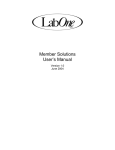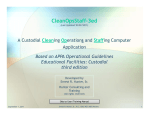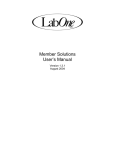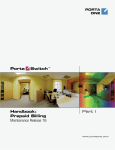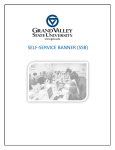Download Banner California Community Colleges Baseline Operational Data
Transcript
Banner California Community Colleges Baseline Operational Data Store Handbook Release 8.1 December 2012 Banner®, Colleague®, PowerCAMPUS®, Luminis® and Datatel® are trademarks of Ellucian or its affiliates and are registered in the U.S. and other countries. Ellucian, Advance, DegreeWorks, fsaATLAS, Course Signals, SmartCall, Recruiter, MOX, ILP, and WCMS are trademarks of Ellucian or its affiliates. Other names may be trademarks of their respective owners. ©2012 Ellucian. All rights reserved. The unauthorized possession, use, reproduction, distribution, display or disclosure of this material or the information contained herein is prohibited. Contains confidential and proprietary information of Ellucian and its subsidiaries. Use of these materials is limited to Ellucian licensees, and is subject to the terms and conditions of one or more written license agreements between Ellucian and the licensee in question. In preparing and providing this publication, Ellucian is not rendering legal, accounting, or other similar professional services. Ellucian makes no claims that an institution's use of this publication or the software for which it is provided will insure compliance with applicable federal or state laws, rules, or regulations. Each organization should seek legal, accounting and other similar professional services from competent providers of the organization’s own choosing. Prepared by: Ellucian 4375 Fair Lakes Court Fairfax, Virginia 22033 United States of America Revision History Publication Date Summary December 2012 New version that supports Banner California Community Colleges Baseline Operational Data Store 8.1 software. Banner California Community Colleges Baseline Operational Data Store 8.1 Contents Chapter 1 Introduction . . . . . . . . . . . . . . . . . . . . . . . . . . . . . . . . . . . . . . . . . . . . . . . . . . . . . . . . . . 1-1 Related Documentation . . . . . . . . . . . . . . . . . . . . . . . . . . . . . . . . 1-2 Prerequisites . . . . . . . . . . . . . . . . . . . . . . . . . . . . . . . . . . . . . . . 1-2 Chapter 2 Administrative User Interface . . . . . . . . . . . . . . . . . . . . . . . . . . . . . . . . . . . . . . 2-1 Set up and synchronize data . . . . . . . . . . . . . . . . . . . . . . . . . . . . . 2-1 Schedule a process . . . . . . . . . . . . . . . . . . . . . . . . . . . . . . . . . . . 2-2 Metadata . . . . . . . . . . . . . . . . . . . . . . . . . . . . . . . . . . . . . . . . . . 2-3 Banner ODS Utilities . . . . . . . . . . . . . . . . . . . . . . . . . . . . . . . . . . 2-4 Run a reconcile group job . . . . . . . . . . . . . . . . . . . . . . . . . . . . . . . . 2-4 Chapter 3 Reporting Views . . . . . . . . . . . . . . . . . . . . . . . . . . . . . . . . . . . . . . . . . . . . . . . . . . . . . 3-1 Summary of CCFS-320 data in CALB ODS . . . . . . . . . . . . . . . . . . . . . 3-1 SECTION_ATTENDANCE_CALB . . . . . . . . . . . . . . . . . . . . . . . . . . . 3-2 STUDENT_ATTENDANCE_CALB . . . . . . . . . . . . . . . . . . . . . . . . . . . 3-6 MEETING_TIME_CALB . . . . . . . . . . . . . . . . . . . . . . . . . . . . . . . . . 3-9 December 2012 Banner California Community Colleges Baseline Operational Data Store 8.1 Handbook Contents iii iv Banner California Community Colleges Baseline Operational Data Store 8.1 Handbook Contents December 2012 1 Introduction The Banner® Operational Data Store (Banner ODS) enables you to extract information from your source administrative systems and reorganize that information into a simplified set of tables and views in the Banner ODS database. End-users can then create and deploy operational and ad hoc reports on this information. Banner ODS provides an extensive and flexible data store as well as business-organized reporting views with fewer columns and improved performance. You can use these views alone or in combination with other views when producing reports. Using this solution, your institution can take full advantage of the data stored in your source system by turning it into applied knowledge that can help you make informed decisions, guide strategic institutional planning and forecasting based on analysis of historical trends, and enhance institutional performance. The Banner California Community Colleges Baseline Operational Datastore (CALB ODS) incorporates CALB data structures allowing users to extract, transform, and load CALB data into the ODS database. The CALB ODS reporting area includes California Community College-specific reporting elements such as contacts hours, resident and nonresident enrollment counts, and apportionment status. This handbook provides details about the objects that have been delivered with CALB ODS. Note This handbook assumes that you have a working knowledge of ODS. If you need more information about how to use Banner and ODS, see “Related Documentation” on page 1-2. The ODS tables and views use Banner naming conventions. For example, tables and views that include “SECTION” in the title relate to the Banner section entity and tables. For example, the AS_SECTION_ATTENDANCE and SECTION_ATTENDANCE_CALB views contain data relating to the Banner section for a course. December 2012 Banner California Community Colleges Baseline Operational Data Store 8.1 Handbook Introduction 1-1 Related Documentation In addition to this handbook, the following documentation supports your work with CALB ODS processing: Banner Operational Data Store Handbook — a user manual describing the setup and use of the Operational Data Store (ODS) product Banner California Community Colleges Baseline Handbook — a handbook describing the setup and use of CALB, which is used with Banner General and Banner Student Banner Getting Started Guide — a user/reference manual that describes the features and components of the Banner system and Banner Online Help Prerequisites Note CALB ODS 8.1 version is designed as a new install and should not be installed on the earlier version of CALB ODS 8.0. CALB ODS 8.0 was a controlled testing release and is not meant for production use. CALB 8.1 includes all the database components and Oracle warehouse components found in CALB ODS 8.0. The minimum required releases for CALB ODS 8.1 are as follows: • Banner ODS 8.4 • Banner General 8.5 or higher • Banner Student 8.5.3 or higher • CALB 8.6.1 or higher • Oracle Database 11.2.0.2.0 or 11.2.0.2.5 (for both source and target databases) • Oracle Warehouse Builder 11.2.0.2.0 or 11.2.0.2.5 1-2 Banner California Community Colleges Baseline Operational Data Store 8.1 Handbook Introduction December 2012 2 Administrative User Interface Options in the Administrative User Interface (UI) enable you to easily perform the tasks required to set up and maintain the Banner® CALB elements of CALB ODS at your institution. This chapter discusses the following topics: • “Set up and synchronize data” on page 2-1 • “Schedule a process” on page 2-2 • “Metadata” on page 2-3 Set up and synchronize data Maintaining current data in Banner ODS is key to producing accurate reports. ODS uses programs (Oracle Warehouse Builder (OWB) mappings) to associate elements in the administrative system with their corresponding elements in ODS. When you run a job (that is, schedule a process using the Administrative UI), it calls the related mappings and loads or updates the data defined by them. ODS includes the following main categories of mappings. • LOAD mappings load data from the administrative system into ODS. These mapping names include a LOAD_ prefix. • REFRESH mappings update ODS with data that has changed in the administrative system. These mapping names include an UPDATE_ or DELETE_ prefix. Typically, these mappings exist in pairs. To perform a complete refresh, you run the DELETE mapping followed by its associated UPDATE mapping. CALB ODS is delivered with a number of mappings already defined. LOAD, DELETE, and UPDATE mappings exist for each CALB composite table in ODS. To make it easier to work with the mappings two jobs, load and refresh, are available to run all the CALB mapping at the same time. December 2012 Banner California Community Colleges Baseline Operational Data Store 8.1 Handbook Administrative User Interface 2-1 CALB ODS delivers the Oracle Warehouse Builder mappings shown in the following table. You can view these from the design center of the Oracle Warehouse Builder client. Mapping Action Reporting View DELETE_MST_MEETING_TIME_CALB Refreshes inserted, deleted or updated rows MEETING_TIME_CALB UPDATE_MEETING_TIME_CALB Refreshes inserted, deleted or updated rows MEETING_TIME_CALB DELETE_MST_SECTION_ATTEND_CALB Refreshes inserted, deleted or updated rows SECTION_ATTENDANCE_CALB UPDATE_MST_SECTION_ATTEND_CALB Refreshes inserted, deleted or updated rows SECTION_ATTENDANCE_CALB DELETE_MST_STUDENT_ATTEND_CALB Refreshes inserted, deleted or updated rows STUDENT_ATTENDANCE_CALB UPDATE_MST_STUDENT_ATTEND_CALB Refreshes inserted, deleted or updated rows STUDENT_ATTENDANCE_CALB LOAD_MST_MEETING_TIME_CALB Loads all rows MEETING_TIME_CALB LOAD_MST_SECTION_ATTEND_CALB Loads all rows SECTION_ATTEND_CALB LOAD_MST_STUDENT_ATTEND_CALB Loads all rows STUDENT_ATTEND_CALB Schedule a process You can schedule a job to run at a specific time. To run load and refresh (update) jobs, select Schedule a Process on the Options menu of the Administrative UI. The Load process uses the Load mapping. • The Load Mapping uses the Composite view to pull data from the Staging tables. • The Load Mapping uses the Composite view to populate the Composite tables. The Refresh process uses the Delete and Update mapping. • The Delete Mapping deletes the Change tables. • The Update Mapping uses the Staging table triggers to populate the Changes tables. • The Update Mapping uses the Change tables with the Composite views to update the Composite tables. 2-2 Banner California Community Colleges Baseline Operational Data Store 8.1 Handbook Administrative User Interface December 2012 The following CALB ODS jobs are available from the Schedule Banner ODS Mappings menu. • Load CALB loads all CALB data in CALB composite tables. • Refresh CALB refreshes changed records in CALB composite tables. In addition to the CALB ODS refresh and load jobs, the CALB mappings are integrated into the Student jobs. • Load Student loads data into the composite tables for reporting views such as STUDENT_ATTENDANCE_CALB, SECTION_ATTENDANCE_CALB, and MEETING_TIME_CALB. • Refresh Student refreshes data in the composite tables for reporting views such as STUDENT_ATTENDANCE_CALB, SECTION_ATTENDANCE_CALB, and MEETING_TIME_CALB. Refer to the Banner Operation Data Store Handbook for instructions on how to run these processes. Metadata Metadata is ‘data about data’, or information and characteristics about data entities such as a column name, description, format, length, origin, and destination. Metadata in ODS provides the following types of information: • Data columns in ODS • Definition of each data column’s business use • Type of data (number, character, date, and so on) • How long the data column is • Where in the source system the data column comes from • Data column’s destination in the target system CALB ODS includes reporting views and source composite views, with the original source tables and source column names. From the Subject Area drop-down list in the Administrative UI, select the CALB option to view the metadata for that area. The metadata can then be viewed online or it can be output to an HTML file. December 2012 Banner California Community Colleges Baseline Operational Data Store 8.1 Handbook Administrative User Interface 2-3 Banner ODS Utilities The Utilities process contains utility jobs or processes that perform various administrative tasks and provide ongoing maintenance of the Banner ODS. For example, the Utilities option enables you to compare the number of rows in one table or multiple tables in the source system with the number of rows in the composite tables in Banner ODS. Run a reconcile group job A custom reconcile group, named CALB-CALB Reporting Views, is available to compare the CALB reporting views to the source tables. Use the following steps to run the custom CALB reconcile group. 1. Click Options from the Administrative UI menu. 2. Click Schedule a Process. 3. Click Banner ODS Utilities. 4. Click Reconcile a Group of Tables. 5. Choose the Reconciliation Type. 6. Choose CALB-CALB Reporting Views from the Reconcile Group drop-down list that you want to run. You can reconcile a group in either ROWCOUNT or DATA mode. The DATA mode reconcile process does a complete row-by-row, column-by-column compare of data. Depending on the amount of data involved, the reconcile process can take a long time to complete in this mode. 7. To display the .sql statement used in the process, check the Show SQL check box. 8. Check the Retain Output Table check box to keep the temporary output table. 9. Enter a Run Date (format dd-mon-yyyy) and Run Time (format hh24:mi:ss). 10. Enter NOW in each field to run the job immediately. 11. Click Submit to run the job. Refer to the Banner Operation Data Store Handbook for more information about Banner ODS utilities and the available parameter options for the reconcile groups. 2-4 Banner California Community Colleges Baseline Operational Data Store 8.1 Handbook Administrative User Interface December 2012 3 Reporting Views CALB data from your source system database is used to populate Banner® ODS composite tables. This data can be retrieved in reports using the CALB ODS reporting views. Use the Administrative User Interface (UI) to maintain and view metadata reports for each composite view (data on the source system used as an intermediate step to produce the composite tables and reporting views) and reporting view. This chapter describes the reporting views included in Banner CALB ODS: • “Summary of CCFS-320 data in CALB ODS” on page 3-1 • “SECTION_ATTENDANCE_CALB” on page 3-2 • “STUDENT_ATTENDANCE_CALB” on page 3-6 • “MEETING_TIME_CALB” on page 3-9 Summary of CCFS-320 data in CALB ODS CALB ODS calculates projected or estimated contact hours and FTES. It does not replace the CALB CCFS-320 reports, which are still the source for actual apportionment contact hours and FTES. The following table provides a summary of some of the major differences in how the projected calculations differ from the actual. CALB CCFS-320 CALB ODS Projected ACTUAL CRN dropped students Apportionment status = C (counted) with the attendance hours for the contact hours. Apportionment status = D (dropped, not counted) to conservatively underestimate contact hours and FTES. ISNC CRNs Uses two-census-averaging method. Only project contact hours and FTES based on the census-1 data; does not evaluate census2 for averaging. December 2012 Banner California Community Colleges Baseline Operational Data Store 8.1 Handbook Reporting Views 3-1 CALB CCFS-320 CALB ODS Projected Number of meetings Uses the “assumed meeting pattern” logic to calculate the SSAACCL displayed value when TBA meetings are included in a daily or actual CRN. Ignores the “assumed meeting pattern” logic. SVRCALX exception messages Any CRN with an exception is not included in CCFS-320 reporting. Only the “not reported” exceptions (STVACCT code with no indicators checked) are considered. All other exceptions are ignored. SECTION_ATTENDANCE_CALB This CALB reporting view includes California CCSF-320-related reporting elements such as enrollment, contact hours, and projected FTES. It returns one row per section. The CCFS-320 numbers are projections or estimates. They have some variations from the final apportionment reported values in order to allow estimating early in the reporting year cycle. For example, the daily contact hour value is used to project FTES for a positive attendance section. Additionally, the section error checking (CCFS-320 report exceptions list) is not considered in the projections. View Column Name Description ACADEMIC_CUTOFF_DATE Academic cutoff date for the section. ACADEMIC_PERIOD Academic period or term associated with the information in the section record. ACADEMIC_PERIOD_DESC Description of the academic period or term associated with the academic period code. ACADEMIC_YEAR Academic year associated with the information in the section record for apportionment reporting. ACADEMIC_YEAR_DESC Description of the academic year associated with the academic year code. ACTIVE_OFFERING_IND Indicator for whether the offering is active. ADMINISTRATIVE_GROUP Administrative group/domain column for future use, not currently populated. 3-2 Banner California Community Colleges Baseline Operational Data Store 8.1 Handbook Reporting Views December 2012 View Column Name Description ATTENDANCE_METHOD California Community College attendance method used for apportionment reporting. Valid values are as follows: • ACTUAL: Actual • DAILY: Daily Census • ISDAY: Independent Study Daily Credit • ISNC: Independent Study Weekly Non-credit • ISWEEK: Independent Study Weekly Credit • UNKNOWN: Setup is incorrect • WEEKLY: Weekly Census ATTENDANCE_METHOD_DESC Description of the California Community College attendance method. CAMPUS Campus on which the section is scheduled. CAMPUS_DESC Description of the campus associated with the campus code. CENSUS1_DATE Census 1 date for the section. CENSUS2_DATE Census 2 date for the section. COURSE_IDENTIFICATION Course subject and course number combined. COURSE_NUMBER Course number associated with the subject for the course. COURSE_REFERENCE_NUMBER Course reference number (CRN) assigned to this section when it was initially added. DAILY_CONTACT_HOURS Calculated daily contact hours for the section. This field is null when the attendance type is WEEKLY, ISWEEK, ISNC, ISDAY, or UNKNOWN. DISTRICT District associated with the campus for which the section is scheduled. DISTRICT_DESC Description of the district associated with the campus code. DROP_CUTOFF_DATE Drop cutoff date for the section. December 2012 Banner California Community Colleges Baseline Operational Data Store 8.1 Handbook Reporting Views 3-3 View Column Name Description END_DATE End date for section. For traditional sections, this is the part-of-term end date defined for this section. For open learning sections, the learner end date is derived as a calculation of duration units, and it is the last possible end date for any student. ENROLLMENT_CUTOFF_DATE Enrollment cutoff date for the section. FIRST_MEET_DATE First date the section meets. This is the CALB calculated start date. MAXIMUM_ENROLLMENT Maximum enrollment for the section. MULTI_SOURCE Institution value for the record when the optional multiinstitution facility feature has been installed and applied for this table/column. MULTI_SOURCE_DESC Institution description for the record when the optional multi-institution facility feature has been installed and applied for this table/column. NUMBER_OF_LAB_MEETINGS Number of lab-only days this section meets. Since this value is derived from a baseline function in SSAACCL, it has a limitation. It will not account for an assumed meeting pattern of Monday through Friday for TBAonly sections. It uses the meeting type lab indicator to determine whether the meeting record is a lab. NUMBER_OF_MEETINGS Number of days this section meets. Since this value is derived from a baseline function in SSAACCL, it has a limitation. It will not account for assumed meeting pattern of Monday through Friday for TBA-only sections. OFFERING_NUMBER Offering number of a course. An offering number can only be used once to identify a subject/course number combination in a term, although multiple offerings of a course can share a 0 offering number. PART_OF_TERM Part of term for the section. PART_OF_TERM_DESC Description associated with the part of term. PROCESS_GROUP Process group/zone column for future use, not currently populated. 3-4 Banner California Community Colleges Baseline Operational Data Store 8.1 Handbook Reporting Views December 2012 View Column Name Description PROJECTED_NONRES_ENROLLMENT Projected number of California non-resident students counted in apportionment. PROJECTED_NONRES_FTES California FTES calculation for non-resident enrollment in a section. This value is calculated as the product of total contact hours and non-resident enrollment divided by 525. PROJECTED_RESIDENT_ENROLLMENT Projected number of California resident students counted in apportionment. PROJECTED_RESIDENT_FTES California FTES calculation for resident enrollment in a section. This value is calculated as the product of total contact hours and resident enrollment divided by 525. REFUND_CUTOFF_DATE Refund cutoff date for the section. START_DATE Start date for the section. For traditional sections, this is the part-of-term start date defined for this section. For open learning sections, the learner start date is used, and it is the first possible start date for any student. SUBJECT Subject area of the course. SUBJECT_DESC Description of the subject associated with the subject code. TERM_LENGTH_MULTIPLIER Weekly or Independent Study Weekly term length multiplier used in total hours calculation for weekly attendance type sections. TOTAL_CONTACT_HOURS Calculated total contact hours for the section. WEEKLY_CONTACT_HOURS Calculated weekly contact hours for the section. This field is null when the attendance type is DAILY, ISDAY, ACTUAL, or UNKNOWN. December 2012 Banner California Community Colleges Baseline Operational Data Store 8.1 Handbook Reporting Views 3-5 STUDENT_ATTENDANCE_CALB This CALB reporting view includes California CCSF-320-related reporting elements such as contact hours and apportionment status. It returns one row per registration record. The CCFS-320 numbers are projections or estimates. They have some variations from the final apportionment reported values in order to allow estimating very early in the reporting year cycle. For example, the daily contact hour value is used to project FTES for a positive attendance section. Additionally, the section error checking (CCFS-320 report exceptions list) is not included in the projections. View Column Name Description ACADEMIC_PERIOD Academic period or term associated with the information in the course record. ACADEMIC_PERIOD_DESC Description of the academic period code. ACADEMIC_YEAR Academic year associated with the information in the course record. ACADEMIC_YEAR_DESC Description of the academic year code. ADMINISTRATIVE_GROUP Administrative group/domain column for future use, not currently populated. APPORTIONMENT_OVERRIDE Registration override code if apportionment override was used for CCFS-320 reporting. Only override codes that are coded as exclude from apportionment are saved here. All other codes are ignored, similar to CCFS-320 reporting. APPORTIONMENT_OVERRIDE_DESC Description of registration override code. APPORTIONMENT_STATUS Code to identify whether this record counts in apportionment or not (and if not, why not) in California CCSF-320 reporting. This is the projected apportionment status. If this is a census CRN using twocensus-averaging (ATTENDANCE_METHOD of ISNC), it is only evaluating census-1. Valid values are as follows • A: Audit • C: Counted • D: Drop • E: Exclude • O: exception 3-6 Banner California Community Colleges Baseline Operational Data Store 8.1 Handbook Reporting Views December 2012 View Column Name Description APPORTIONMENT_STATUS_DESC Description of the apportionment status. CALIFORNIA_RESIDENT_IND Indicator for whether the student is an in-state resident or out-of-state non-resident. CONCURRENT_HIGH_SCHOOL_IND Indicator for whether the student is concurrently enrolled in high school. CONTACT_HOURS Contact hours for the registration record. If the attendance method for the section is DAILY, ACTUAL, or ISDAY, this is the section projected daily contact hours. If the attendance method is WEELKY, ISNC, or ISWEEK, this is the projected weekly contact hours. This value is null if not counted in apportionment. COURSE_IDENTIFICATION Course subject and course number combined. COURSE_NUMBER Course number associated with the subject for the course. COURSE_REFERENCE_NUMBER Course reference number (CRN) assigned to this section when it was initially added. HOURS_ATTENDED Number of hours the student attended this class. This is used in apportionment calculations for positive attendance courses, but it is not used for the projected CCFS-320 calculations. LAST_ATTEND_DATE Last date the student attended the class if it was recorded by the instructor. LENGTH_MULTIPLIER Length multiplier for the registration record. If the attendance method is ACTUAL, DAILY, or ISDAY, this is the number of meetings. If the attendance method is WEEKLY, this is the term length multiplier. If the attendance method is ISNC or ISWEEK, this is the independent study term length multiplier. MULTI_SOURCE Institution value for the record when the optional multiinstitution facility feature has been installed and applied for this table/column. MULTI_SOURCE_DESC Institution description for the record when the optional multi-institution facility feature has been installed and applied for this table/column. December 2012 Banner California Community Colleges Baseline Operational Data Store 8.1 Handbook Reporting Views 3-7 View Column Name Description OFFERING_NUMBER Offering number of a course. An offering number can only be used once to identify a subject/course number combination in a term, although multiple offerings of a course can share a 0 offering number. PART_OF_TERM Part of term for the section. PART_OF_TERM_DESC Description associated with the part of term. PERSON_UID Student PIDM. Specifies the internal identification number of the student. PROCESS_GROUP Process group/zone column for future use, not currently populated. REG_STATUS_AT_CENSUS Registration status from audit history as of the census-1 date. REG_STATUS_AT_CENSUS_DESC Description of the census-1 registration status. REG_STATUS_AT_CUTOFF Registration status from audit history as of the academic cutoff date. REG_STATUS_AT_CUTOFF_DESC Description of the academic cutoff registration status. REG_STATUS_CURRENT Current registration status associated with this CRN. REG_STATUS_CURRENT_DESC Description of current registration status. REGISTRATION_SEQUENCE_NUMBER Registration sequence number. SUBJECT Subject area of the course. SUBJECT_DESC Description of the subject associated with the subject code. TOTAL_CONTACT_HOURS Total contact hours for the registration record when the apportionment status is C (Counted). 3-8 Banner California Community Colleges Baseline Operational Data Store 8.1 Handbook Reporting Views December 2012 MEETING_TIME_CALB This CALB reporting view includes California Community College contact hour calculations and other scheduling data for each meeting record in a section. A meeting record is a session defined for a section or course reference number (CRN). This view has no special adjustments for CCFS-320 projections. View Column Name Description ACADEMIC_PERIOD Academic period or term associated with the course reference number (CRN) of the meeting time record. ACADEMIC_PERIOD_DESC Description of the academic period code. ACADEMIC_YEAR Academic year associated with the course reference number (CRN) of the meeting time record. ACADEMIC_YEAR_DESC Description of the academic year code. ADMINISTRATIVE_GROUP Domain column for future use, not currently populated. BEGIN_TIME Begin time of the session being scheduled. This is a required field and must be in HHMM format using 24hour time. BREAK_MINUTES Calculated California Community College break minutes. This is calculated based on the begin and end time of the meeting, and is used only when the contact hours override indicator is unchecked and the contact hours are calculated (not manually entered). BUILDING Building where the session is to take place. This is not required when scheduling session meeting times, but is required when scheduling session meeting rooms. BUILDING_DESC Description associated with the building code. BUILDING_SITE Site or location where the student is attending or obtaining instruction. BUILDING_SITE_DESC Description associated with the site or location. CATEGORY Session indicator. CLASS_TYPE Session class type. CLASS_TYPE_DESC Class type description. December 2012 Banner California Community Colleges Baseline Operational Data Store 8.1 Handbook Reporting Views 3-9 View Column Name Description COMMITTEE Committee. COMMITTEE_DESC Description associated with the committee. COURSE_CAMPUS Campus scheduling the offering. COURSE_CAMPUS_DESC Description associated with the course reference number’s (CRN’s) campus. COURSE_IDENTIFICATION Course subject and course number combined. COURSE_NUMBER Course number associated with the course reference number (CRN) of the meeting time record. COURSE_REFERENCE_NUMBER Course reference number (CRN) CRN assigned to this course section when it was initially added. END_DATE Session meeting end date. END_TIME End time of the session being scheduled. This is a required field and must be in HHMM format using 24hour time. EVENT_FUNCTION Event function. EVENT_FUNCTION_DESC Description associated with the event function. FIRST_MEET_DATE First day the scheduled meeting will occur. This is the CALB calculated start date for this session. It uses the session meeting start date (START_DATE) and the checked day indicators to calculate the first actual meeting date related to this session. FRIDAY_IND Indicates that the session meets on Fridays. HOURS_OVERRIDE_IND Indicator for whether the total, weekly, and daily hours calculations are overridden by manual entry. INSTRUCTION_DELIVERY_MODE Instructional delivery mode of the session. INSTRUCTION_DELIVERY_MODE_DESC Instructional delivery mode. LAB_IND Indicator for the session’s meeting type code specifying whether the meeting is a lab. MEETING_ACTIVITY_DATE Date record was inserted or updated. 3-10 Banner California Community Colleges Baseline Operational Data Store 8.1 Handbook Reporting Views December 2012 View Column Name Description MEETING_HOURS Calculated California Community College contact hours per week for the meeting. This is calculated when the hours override is set to No, and is manually entered when the hours override is Yes. MEETING_HOURS_DAY Calculated California Community College contact hours per day for the meeting. This is calculated when the hours override is set to No, and is manually entered when the hours override is Yes. MEETING_HOURS_TOTAL Total California Community College contact hours for the meeting. This is calculated when the hours override is set to No, and is manually entered when the hours override is Yes. MEETING_TYPE Meeting type. MEETING_TYPE_DESC Description associated with the meeting type. MONDAY_IND Indicates that the session meets on Mondays. MULTI_SOURCE Institution value for the record when the optional multiinstitution facility feature has been installed and applied for this table/column. MULTI_SOURCE_DESC Institution description for the record when the optional multi-institution facility feature has been installed and applied for this table/column. PART_OF_TERM Part of term associated with the course reference number (CRN) of the meeting time record. PART_OF_TERM_DESC Description associated with the part term code. PROCESS_GROUP Zone column for future use, not currently populated. ROOM Room where the session is to take place. This is not required when scheduling session meeting times, but is required when scheduling a session meeting building. SATURDAY_IND Indicates that the session meets on Saturdays. SCHED_CONFLICT_OVERRIDE_DESC Description associated with the schedule conflict override. SCHEDULE Schedule type code (such as lecture, lab, self-paced, and so on) for the session. December 2012 Banner California Community Colleges Baseline Operational Data Store 8.1 Handbook Reporting Views 3-11 View Column Name Description SCHEDULE_CONFLICT_OVERRIDE Indicator for whether an override was required to schedule this meeting record and, if so, whether it was overridden due to a room conflict, time conflict, or both. SCHEDULE_DESC Description associated with the schedule type code. SCHEDULE_STATUS Schedule status. SCHEDULE_STATUS_DESC Description associated with the schedule status. SECTION Section of the course reference number (CRN). This is called the offering number in the SECTION_ATTENDANCE_CALB reporting view. SECTION_DESC Section of the course. SESSION_CREDIT_HOURS Session credit hours. START_DATE Session meeting start date. SUBJECT Subject code associated with the course reference number (CRN) of the meeting time record. SUBJECT_DESC Description of the subject code. SUNDAY_IND Indicates that the session meets on Sundays. THURSDAY_IND Indicates that the session meets on Thursdays. TITLE_LONG_DESC Long title of the course. TITLE_SHORT_DESC Short title of the course. TO_BE_ANNOUNCED_IND To be announced indicator for the session’s meeting type code, specifying whether the meeting days, meeting times, or both are currently unscheduled. TUESDAY_IND Indicates that the session meets on Tuesdays. WEDNESDAY_IND Indicates that the session meets on Wednesdays. 3-12 Banner California Community Colleges Baseline Operational Data Store 8.1 Handbook Reporting Views December 2012






















